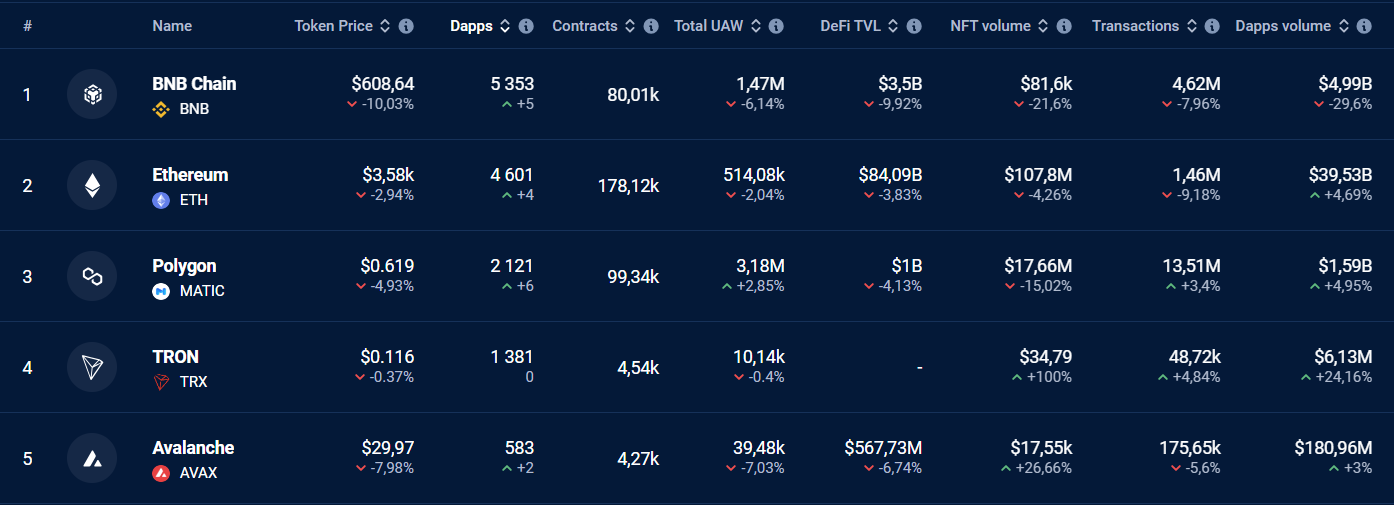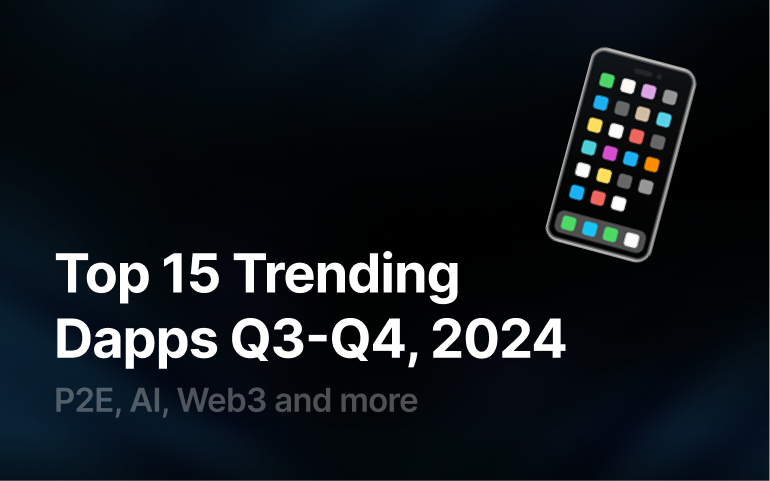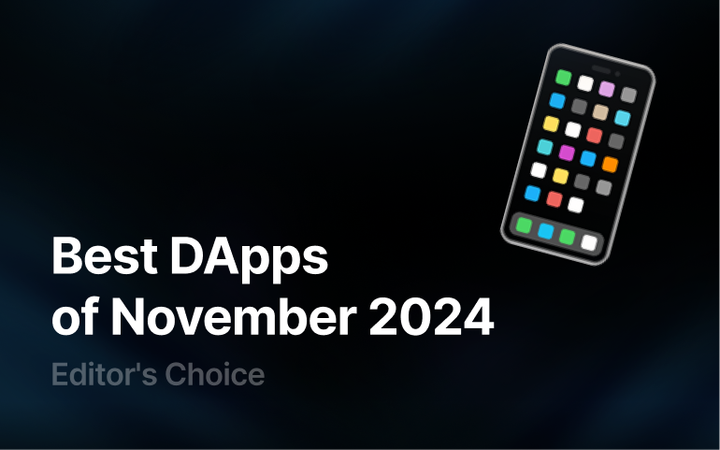Top-5 blockchain platforms for developing dApps in 2024

What are dApps and why do we need them?
Recently, decentralized applications (dApps) have become a real hit. They can completely change our digital interactions
What is the essence of dApps and why are they better than traditional applications?
Traditional applications are controlled by large companies, such as app stores or platforms. dApps, on the other hand, run on decentralized networks, which are not dependent on a single owner. This means that users gain more control and security. Let's highlight the main advantages:
- Decentralization - dApps are not dependent on a single center. They operate on distributed networks, which makes them more resilient and secure.
- Transparency - All transactions and data in dApps are stored in an open database, making them transparent and difficult to counterfeit.
- Security - With no single point of failure, dApps are less vulnerable to hacking attacks and other threats.
- Autonomy - dApps operate without intermediaries, which reduces costs and speeds up transaction processes.
How do dApps work?
dApps are built on decentralized blockchain networks. Here are the main components:
- Decentralized network (dApps run on multiple computers, not on a single server. Usually, this is a blockchain that stores all data and transactions)
- Tokens (dApps often use digital tokens, such as cryptocurrencies, for payments and value exchanges)
- Consensus (To ensure all transactions are valid and secure, dApps use consensus mechanisms such as Proof of Work or Proof of Stake)
- Smart contracts (Smart contracts are programs that automatically execute the terms of an agreement. They are stored on the blockchain and operate without human intervention)
With dApps, users have more control over their data and assets. Their popularity is growing thanks to their security, transparency, and independence. dApps have the potential to transform many sectors, from finance to healthcare, and they represent the future. If you decide to become an important part of it, the first step in creating your decentralized application will be choosing the right blockchain network.
Choosing the right blockchain network
It's like choosing a place to build: everything depends on it. When creating a product on the blockchain, it is important to choose the right network. This decision affects everything from the speed of operation to the costs. Here's what to consider.
Product and users
- Find out which blockchains they already have wallets and assets in. Building on popular platforms among your audience will simplify adoption.
- If there are already successful products in your niche on a particular blockchain, that's a good sign. It means the technology is suitable for your scenario.
- Pay attention to wallets, the possibility of using fiat, regulatory requirements, and documentation. These factors may be more important than the purely technical specifications.
Technical aspects
- How many transactions per second can the network support? How quickly are transactions confirmed?
- What language is used for smart contracts? Are there any limitations? The compatibility of the virtual machine is also important.
- What is needed for migration or connection with other networks in the future?
Community
- Do you know the development team? How open are they?
- Is the community large and active enough for this network?
Currently, according to dappradar, a little over 60 blockchain networks are suitable for creating decentralized applications (dApps).
Here are the top 5 blockchain networks with the largest number of apps created on them:

Let's take a closer look at each of them.
BNB Chain
BNB Chain is a dynamic blockchain ecosystem developed to enhance decentralized applications and services through a multi-tiered structure. At the beginning of 2022, Binance Chain and BSC were merged into BNB Chain. All the best features and smart contracts now operate within BNB Chain. Just a few months after the merger, BNB Chain broke out as a leader, surpassing Ethereum in the number of active DApps. Today, more than 5300 DApps are registered on BNB, making it the largest network in this aspect. Thus, BNB and Ethereum are the real giants in the world of blockchain applications, each with its unique specificity. BNB attracts users with its low transaction fees, high scalability, and cost-effective use.
Advantages of BNB Chain:
- Low transaction fees;
- Fast transaction processing;
- Extensive user base.
Disadvantages of BNB Chain:
- Concerns about centralized management;
- Tough competition with other networks compatible with Ethereum.
Ethereum
Ethereum confidently occupies the top lines in the world of cryptocurrencies and remains a favorite for DApp development thanks to its fame and reliability. This network not only operates - it actively develops, offering developers a top platform for creating applications. However, before starting work, pay attention to the transaction fees, which are comparatively high at Ethereum; they can play a key role in choosing a platform.
Ethereum was the first blockchain to support smart contracts, and it can now boast a powerful community of developers and an extensive library of open code, available to newcomers. Moreover, the platform often becomes the choice for business developers who launch their corporate blockchain projects.
Advantages of Ethereum:
- Huge and active community of developers;
- Mature and well-established ecosystem;
- Advanced features for working with smart contracts.
Disadvantages of Ethereum:
- High transaction fees, which is always unpleasant;
- Scalability issues without Layer 2 solutions.
Polygon
Polygon applies advanced second-level scaling technologies and has a unique structure with independent blockchains and sidechains, which reduce the limitations of base chains and increase compatibility with Ethereum. Plasma technology also reduces the load on main blockchains, making Polygon an effective platform for creating dApps.
Compared to Ethereum, which faces problems such as limited bandwidth, high transaction costs, and slowdowns due to its popularity, Polygon offers solutions that ensure easy integration and enhanced security. Thanks to support for interaction with Ethereum and other blockchains, Polygon simplifies development and expands capabilities through modular solutions.
Advantages of Polygon:
- Low transaction fees make it cost-effective;
- High processing speed ensures system responsiveness;
- Strong developer support creates ideal conditions for innovations.
Disadvantages of Polygon:
- Dependence on Ethereum, which can be a problem;
- Competition with other scaling technologies requires constant innovation to maintain competitiveness.
TRON
TRON, launched in 2017 by visionary Justin Sun, quickly emerged as a revolutionary platform for decentralized applications and smart contracts, with a special focus on the rapidly developing industries of media and entertainment. This blockchain attracts with its perfect combination of high-speed transactions, minimal fees, and a friendly environment for creative developers and content makers.
With the ability to process up to 2000 transactions per second, TRON is your ideal choice for projects requiring high performance and speed. High fees? Forget about it. On TRON, fees are symbolic - just $0.000005 per transaction, making this blockchain suitable for everything from microtransactions in games to the distribution of media content.
Advantages of TRON:
- Instant transaction processing with the highest throughput;
- Extremely low fees, making it accessible for a wide range of uses;
- Excellent support for projects in the media and entertainment industries, backed by a strong platform.
Disadvantages of TRON:
- Relatively smaller community compared to the largest blockchains;
- Slow innovation adoption, which may hinder its development in some areas.
Avalanche
Avalanche is a mega-scalable network that is ideally suited for decentralized applications, providing cool transaction speeds and super-low fees. This blockchain is designed to scale easily without losing speed or decentralization. The platform consists of three blockchains: Exchange Chain (X-Chain) manages assets and transactions, Contract Chain (C-Chain) is used for launching smart contracts, and Platform Chain (P-Chain) coordinates validators and subnets. The Avalanche-C Chain operates on the Snowman consensus protocol and supports smart contracts compatible with EVM, giving developers the freedom to create DApps on C-Chain.
Advantages of Avalanche:
- Excellent throughput and minimal delay, ensuring fast and efficient platform operation;
- Flexible structure, allowing easy adaptation to various developer needs.
Disadvantages of Avalanche:
- As this is a relatively new project, it is still forming and developing its ecosystem.
Choosing the right blockchain network is key to the success of your project. Explore the possibilities of each platform and choose the one that best meets your requirements and goals. Good luck in creating your digital masterpiece! 🚀








